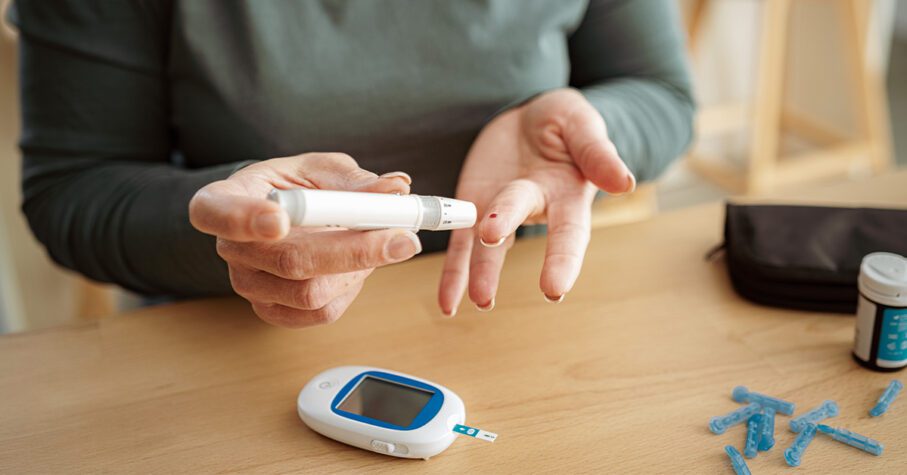
This cover has been designed using resources from Freepik.com
Diabetes is a condition that develops when the body cannot effectively use insulin, or when it does not make enough insulin in the first place. Insulin is needed to help your body break down the sugar it needs for energy. So, being able to use it properly is essential for living a healthy and happy life.
Did you know?
Nearly 2.8 million Canadians (7.3%) age 12 and above report being diagnosed with diabetes,1 with more men (8.2%) than women (6.5%) having diabetes. Additionally, many more people are at risk of developing diabetes.
What are the types of diabetes?
There are three common types of diabetes.
Type 1 diabetes
Type 1 diabetes2 happens when the body does not produce its own insulin. It is not preventable and risk factors are not well understood compared to other type of diabetes.
- About 10% of those with diabetes have type 1.
- Children, teenagers and young adults are at higher risk of developing type 1 diabetes.
- Type 1 diabetes is managed by taking insulin and other medications as prescribed by your doctor and by monitoring blood sugar levels.
- Symptoms can develop quickly, ranging from unusual thirst to tingling and numbness in the hands or feet. 3
- Having a parent or sibling with type 1 or type 2 diabetes increases your risk. 4
Type 2 diabetes
People develop type 2 diabetes5 when their bodies cannot use the insulin it produces, or the body does not create enough insulin. It frequently develops in adulthood but can develop sooner. Unlike type 1, this type of diabetes can be managed with healthy eating and exercise, but some people still need medication or insulin.
- Type 2 diabetes affects 90% of Canadians with diabetes.
- Adults over 40 are at a higher risk for type 2 diabetes.
- Symptoms include fatigue, frequent urination and unusual thirst.6
- Symptoms are slower to progress compared to type 1.
- Sometimes, people with type 2 diabetes show no symptoms at all.
Prediabetes can also be a precursor to type 2 diabetes.7 This is where people display higher-than-normal blood sugar levels that are not high yet enough to be considered type 2 diabetes. If you are diagnosed with prediabetes, it’s an early sign to speak to your doctor and adjust your lifestyle.
Gestational diabetes
Gestational diabetes8 is a temporary type of diabetes that happens during pregnancy and can affect between three to 20 per cent of expectant mothers. Lifestyle and other factors also play a role in its development.
It usually disappears after the baby is born; however, it can increase the risk of mother and baby developing diabetes later.
How can I reduce my risk for developing diabetes?
Although there is no cure for diabetes, you can reduce your risk of developing type 2 by changing your lifestyle habits. Some great ideas include:9
- Design a healthy eating plan.
- Stay physically active.
- Manage your weight.
- Get professional medical support and advice.
Factors linked to diabetes10
Various factors can increase your chances of developing diabetes. Some of these factors are genetic, but others are caused by your lifestyle. Some common factors linked to diabetes are:
- High blood pressure and/or high blood cholesterol
- Overweight and/or abdominal obesity
- Giving birth to a baby larger than 4 kg (9 lb)
- Conditions including schizophrenia and obstructive sleep apnea.
- A family history of diabetes or prediabetes
Canada Protection Plan and Diabetes
Canada Protection Plan, a Foresters Financial™ company has products that can help living with diabetes easier. Our No Medical11 life insurance could help you get sufficient coverage to make staying stress free and managing medical expenses and other costs easier.
Get in touch with one of our expert advisors today
or request a no-obligation quote.

Sources
1 https://www150.statcan.gc.ca/n1/pub/12-581-x/2022001/sec8-eng.htm (2022)
2 https://www.diabetes.ca/about-diabetes-(3)/type-1 (2024)
3 https://www.diabetes.ca/en-CA/about-diabetes-(3)/type-1/symptoms (2024)
4 https://www.diabetes.ca/type-2-risks/risk-factors—assessments (2024)
5 https://www.diabetes.ca/about-diabetes-(3)/type-2 (2024)
6 https://www.canada.ca/en/public-health/services/diseases/type-2-diabetes.html (2023)
7 https://www.mayoclinic.org/diseases-conditions/prediabetes/symptoms-causes/syc-20355278 (2023)
8 https://www.diabetes.ca/about-diabetes/gestational (2024)
9 https://www.diabetes.ca/type-2-risks/preventing-diabetes (2024)
10 https://guidelines.diabetes.ca/GuideLines/media/Docs/Patient%20Resources/diabetes-fact-sheet.pdf (2018)
11 Insurability depends on the answers to medical and other application questions and underwriting searches and review
™ Foresters Financial and Foresters are trade names and trademarks of The Independent Order of Foresters (a fraternal benefit society, 789 Don Mills Road, Toronto, ON Canada M3C 1T9) and its subsidiaries.
Canadian Protection Plan and Foresters Financial do not provide medical advice. The information contained on this website is for informational purposes only, and is not a substitute for professional medical advice, diagnosis, or treatment. Please seek the advice of a medical professional with any questions you may have regarding a medical condition or treatment, and/or before undertaking any new healthcare regimen.
424083 CAN (10/24)







